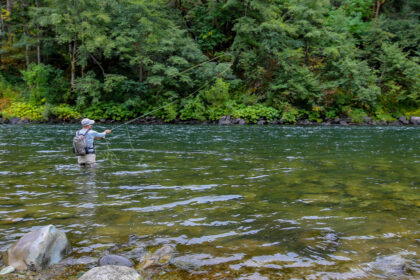
There are three basic rig setups to consider when trout fishing in a lake, but using a method that keeps the bait close to the bottom works well in lakes where trout try to hide from the sunlight.
To go fishing for trout with a slip sinker rig, you need to tie your line to a proper sliding sinker and swivel. Using this in combination with a floating bait allows you to target trout near the bottom of the lake.
While there are plenty of rigging options for fishing trout, a slip sinker rig offers works well when used in a lake. Keep reading to learn why it works so well, what to consider when choosing equipment, and how you can make this method work for you.
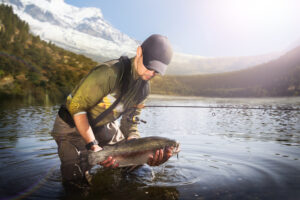
Why Trout Fish in a Lake with a Slip Sinker Rig?
A slip sinker rig is not only one of the most common and useful rigs to master, but it works perfectly for fishing for trout at the bottom of a lake.
Trout, like most other fish, don’t have eyelids, and they like to hang out close to the bottom of a lake, pond, or stock tank to protect their eyes. This is especially true in areas with high sunlight and little shade.
When you’re using this rig, it’s easy to cast it out and allow it to settle for both passive and active fishing. You can use it for both stationary and bottom fishing, and it works well with free swimming and floating baits.
A slip sinker rig holds the bait in place but doesn’t drag it to the bottom, so fish have more confidence in approaching it. They can take the bait and split without meeting resistance, increasing the chances of sinking the hook.
A slip sinker rig is generally easy to figure out, but you may need to test out different sinkers and bait options. You should also consider what you want to do while casting this rig. After some trial and error, you can apply it to plenty of situations, including trout fishing in a lake.
Best Equipment
Most slip sinker rigs use:
-
A ⅛ or ¼ oz sliding sinker
-
A barrel swivel
-
Floating bait
There are plenty of sinker varieties to choose from, both mobile and static. Most slip sinker rigs use something that can glide along the bottom of the lake, like an egg weight. Static sinkers, like a pyramid, will keep your bait in one place.
The barrel swivel allows the bait to move naturally through the water, and it’s an essential part of the rig. You can replace this with a split shot, but it weakens the line.
Carolina rigs use a bead to prevent the weight from slamming into the swivel when you retrieve your catch. This protects the knot on the swivel from damage, and it’s beneficial for more active fishing situations.
Floating bait is essential for trout fishing in a lake with a slip sinker rig. Smaller minnows hooked through the lip work well for live bait, but you can also use powerbait or worms injected with air to prevent the bait from falling to the lade bed.
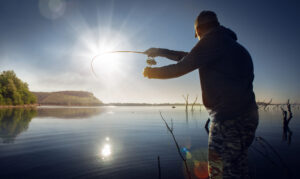
When to Use a Slip Sinker Rig for Trout Fishing in a Lake
Most lakes hold trout in water that’s deeper than 5 to 10 feet, and a slip sinker rig works well here. You can use it easily from the shore by casting it far, and the versatile rig covers quite a bit of water.
You want to use this when you anticipate most of your population to be at the bottom of the lake. This happens more often in bright conditions where the fish won’t have much relief from the light. Slip sinker rigs help you out in weedy areas where the fish have more choice over the depth at which they feed.
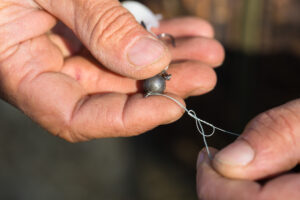
How to Make a Slip Sinker Rig for Trout Fishing in a Lake
There are two forms of slip sinker rigs you can use when trout fishing in a lake, and there isn’t much difference between the two.
Standard Slip Sinker Rig
A standard slip sinker rig involves threading a sliding sinker (usually a ¼ oz bullet or egg) to your main line. You then tie the line to a barrel swivel, and then attach a leader to the other end that attaches to your hook.
Hook size depends more so on what bait you’re using (i.e. sizes 8 to 12 for minnows).
Carolina Rig
A Carolina rig involves a similar setup. You thread your main line through a sliding sinker, then thread that line through a bead before tying it to your swivel or snap swivel. Plastic beads work fine, but more expensive rubber ones offer more protection.
You usually use a Carolina rig over the standard setup if you’re fishing actively or expect larger fish.
Slip Sinker Rig Without a Swivel
You can modify either of these rigs for use without a swivel by pinching a split shot between your hook and slip sinker. The sinker can’t pass the split shot, but you weaken your line significantly when you pinch it.
In most cases, it makes more sense to invest in the swivel.
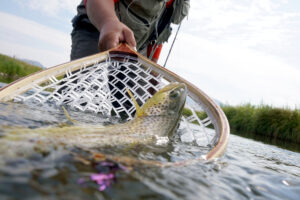
Using Slip Sinker Rigs to Trout Fish in a Lake
Using a slip sinker rig leans toward passive fishing. You can cast your line in a promising spot and then sit and wait for a bite, checking regularly to ensure the bait is still on the hook.
Carolina rigs are used more often for fishing actively while using a floating lure. After casting your line, let it sink to the bottom and then retrieve it with a jigging motion.
If you’re not having any luck, you can adjust your line to achieve a different depth so the bait floats higher or lower. Navigating around weeds at the bottom of the lake can help you target fish feeding at different levels.
Final Thoughts
A slip sinker rig may be the only one you need for trout fishing in a lake. It meets the trout where they’re most likely to be, and it offers you plenty of lenience in terms of how actively you fish and where the bait ends up.
Prepare to spend some time and money figuring out which bait and sinkers work best for how you fish and you are. There’s a slight learning curve from traditional bobber fishing, but it’s bound to pay off.



